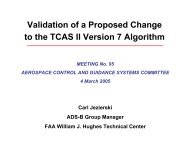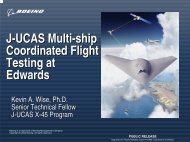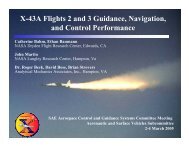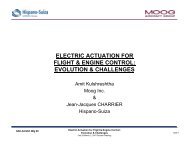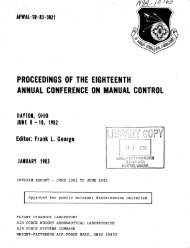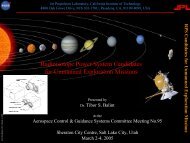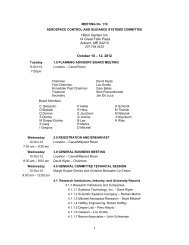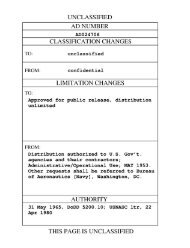Report of the Second Piloted Aircraft Flight Control System - Acgsc.org
Report of the Second Piloted Aircraft Flight Control System - Acgsc.org
Report of the Second Piloted Aircraft Flight Control System - Acgsc.org
Create successful ePaper yourself
Turn your PDF publications into a flip-book with our unique Google optimized e-Paper software.
lication <strong>of</strong> equations. - The method <strong>of</strong> applying equations (2)<br />
<strong>the</strong> calculations <strong>of</strong> <strong>the</strong> traneient is presented in figure 3.<br />
As ahown in figure 3, <strong>the</strong> end <strong>of</strong> <strong>the</strong> acceleration phaee 1; defined by<br />
<strong>the</strong> inflection point <strong>of</strong> <strong>the</strong> solution <strong>of</strong> equation (6) for E > 1. For<br />
E < 1, <strong>the</strong> second order equation may be used to approximate <strong>the</strong> entire<br />
t&mient and <strong>the</strong>refore <strong>the</strong> inflection point need not be evaluated.<br />
Figure 4 is a plot <strong>of</strong> rise time against no-load time conatant for a<br />
range <strong>of</strong> values <strong>of</strong> inertia index. The chart is computed from <strong>the</strong> relations<br />
shown in figure 3. The rise time is defined as <strong>the</strong> time to reach<br />
90 percent <strong>of</strong> <strong>the</strong> flnal value.<br />
erinrntal response. - Figure 5 shows <strong>the</strong> characteristic agreement<br />
bctwe?calcuiated and meataured responses (reported in reference 1) in<br />
a series <strong>of</strong> rune in vhidh <strong>the</strong> factors that determine <strong>the</strong> parameters T<br />
and E have been varied. Ae can be sten, t& calculated rehnsee<br />
have provided a close agpmdmation <strong>of</strong> <strong>the</strong> actual responses over a wide<br />
range <strong>of</strong> conditions. It may be <strong>of</strong> particular interest to note that <strong>the</strong><br />
effect <strong>of</strong> magnitude <strong>of</strong> <strong>the</strong> input step ars predicted by <strong>the</strong> approximating<br />
tiquatiom is evident in <strong>the</strong> measured responses.<br />
Peak cylinder pressure during a transient. - In a transient under a<br />
heavy load, <strong>the</strong> downstream cylinder presaure may exceed <strong>the</strong> supply pressure.<br />
For this reason an evaluation <strong>of</strong> <strong>the</strong> peak cylinder pressure is<br />
significant from a structural standpoint . It is shown in reference 1<br />
that <strong>the</strong> ratio <strong>of</strong> <strong>the</strong> mnxrnnlm cylinder pressure to <strong>the</strong> supply pressure<br />
is a function solely <strong>of</strong> <strong>the</strong> inertia index. The relation derived in reference<br />
1 is plotted in figure 6. Also ihom in figure 6 are experimental<br />
values reported in reference 1.<br />
Response to a Sinu~oidal Input<br />
Basic dynsmic considerations. - It has been shown that under an<br />
inertia load, <strong>the</strong> trans'ient response <strong>of</strong> <strong>the</strong> servomotor is nonlinear,<br />
The basic character <strong>of</strong> <strong>the</strong> transient response has been shown to vary<br />
with time in <strong>the</strong> transient. It can <strong>the</strong>refore be expected that <strong>the</strong> frequency<br />
response will also exhibit noanear characterXstics and that <strong>the</strong><br />
basic character <strong>of</strong> <strong>the</strong> response will vary with <strong>the</strong> frequency <strong>of</strong> <strong>the</strong><br />
input.<br />
Law frequency amplitude attenuation and phase shiFt. - At low fre-<br />
",.s..ln4aa +'ha err..-.-., &La& --& ^, &I-^ ^o rL- ---- r-- --- ----a. - 1



